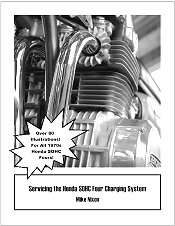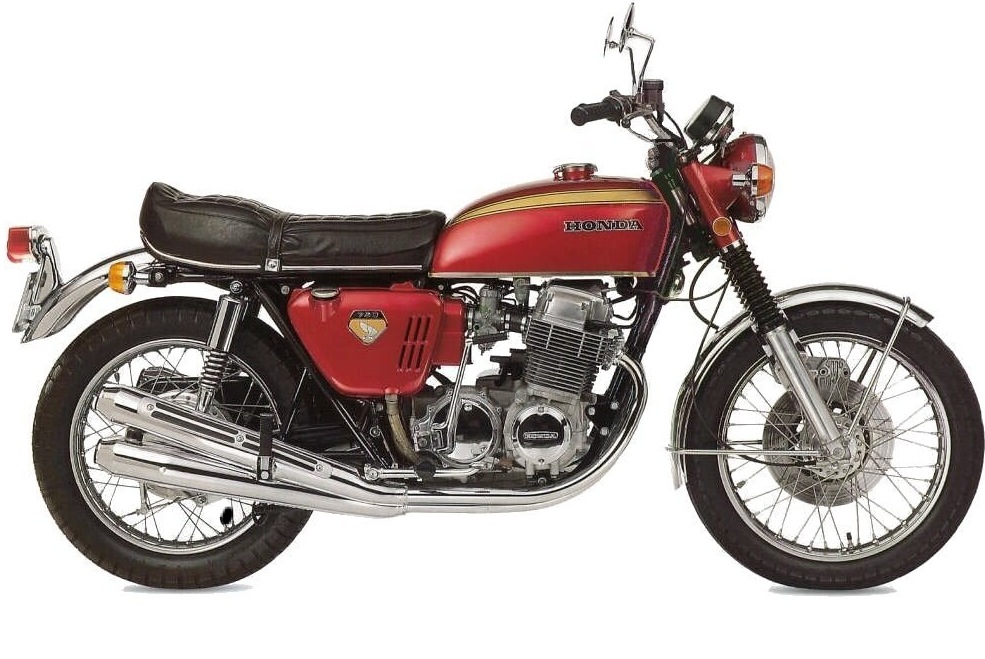  ® ®
|
In Defense of 70s and 80s Honda Charging Systems |
On vintage Honda forums I see a lot of bashing of these bikes' charging systems. That's messed up. The people asking the questions are badly served by these forums' "experts" who tell them they can't run even a quartz headlight. After a lot of thought, and some invigorating (if frustrating) give and take on the forums, I think the issue may boil down to two things. First, folks demand more of their bikes electrically than ever before. Living in the west I am not really in tune with the severe cold riding ethic. Who will argue with the fact that a bike whose charging system is rated at only 200 watts isn't going to do well with 180 watts of electric jackets and pants and whatnot plugged in? Not me. That's an easy one. But it also begs the question: what about the summer months? Is it only during winter the bikes' electrical systems are "junk"? At all other times they're okay? But I'm not reading that logic on the forums. These Internet trash talkers just want something to complain about, or what? Perplexing. The second factor is more understandable. But, well, humorous. It's rpm. In this day when all but ultrasport bikes have surprisingly low rev limits and wonderfully broad powerbands, vintage Honda SOHC Four owners I believe have overlooked something very important and very basic. Simply this: 1970s Honda fours are revvers. You just don't properly ride them at 2,000 rpm. Why would you? They don't make any power down there, for one thing. They don't feel right, sound right, go right. I just don't get this, but it has to be the major part of the answer as to why forum members "dis" the charging systems on these bikes. And that brings up another mystery, the forums' fixation on vintage Honda fours not charging at idle. Huh?! So what? They never did, even new, and neither did any modular style excited field charging system equipped bike. What exactly is the point? The only reason cars, whose alternators are also excited field type, charge at idle, is their alternators are "pullied up", that is, their rubber belt drive ratio is multiplied upward for greater ouput. Our 70s Hondas don't have this advantage, their charging systems being made a part of the engine. Their electromagnet charging systems therefore don't exceed an equilibrium point until 1700 rpm (average spec and the target--my 500 is at 1300). Again, so? I am at a loss as to why forums insist these systems should charge at idle. How often do you operate a bike at idle? And even if you do sit at tollway booths or in traffic a bit, that's not going to kill your battery unless you have a fault im either your battery or your charging system. I just can't understand why folks don't realize no one even gave this a thought until the emergence of user forums. The fact is, maintained correctly and ridden properly, and excepting loads of heated clothing, Garmins and toaster ovens, there is plenty of electrical margin in these old bikes. Do these naysayers really believe that CB350F, CB550 Four and CB750 Four riders struggled with dead batteries back in the day? Really? My 200-watt1 alternator equipped CB500 four had an 80-watt quartz headlight, current-doubling high output ignition coils, ignition points set to maximum dwell, an alarm system, and even more powerful horns. And never had a problem. Of course I had the regulator turned up, a viable and legitimate adjustment option available to the riders of many of these old fours, despite some on forums who recommend against it (and that contrary to Honda's own instruction). I also still own a CBX having a slightly stronger 300-watt system. Once the CBX's drive clutch is attended to and you resign yourself to replacing brushes every 15,000 miles, it is likewise faultless and much more than adequate, at least to this So Cal resident. And this is a touring bike. Don't dismiss the standard vintage Honda's charging system, and certainly don't do so out of hand. While it can't compare with that found on a modern luxo-tourer, it is pretty powerful for all that and has served owners of these machines more than adequately by supporting more than original equipment loads for almost three generations. Postscript October 2014: I see the forum experts are still at it, telling folks they can't run both Dyna coils and a quartz headlight on their CB550s. Sigh. Postscript May 2017: I have just acquired a replacement for the bike I rode in the 70s, a CB500 Four. A "barn find" with just 7400 actual miles, unrestored, rusty and dusty but mechanically strong and all there. Woohoo! And guess what? The charging system works a treat! Postscript October 2022: Still enjoying my 1973 CB500. A survivor, all its systems work as expected. It's as if it were brand new. Loving it! Postscript February 2023: I see the sohc4 guys are still bitching about their sohc fours not charging at idle. 1 This is official Honda specification, CB500/550 manual, published 1974, page 136.
|
|
Please don't overlook the fact that I have written a booklet covering troubleshooting Honda SOHC four charging systems. I think you'll find it comprehensive and resourceful.
|
|

|
Servicing the Honda SOHC Four Charging System |
© 1996-2021 Mike Nixon
